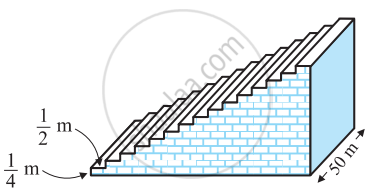Advertisements
Advertisements
Question
In an A.P. sum of three consecutive terms is 27 and their products is 504. Find the terms. (Assume that three consecutive terms in an A.P. are a – d, a, a + d.)
Solution
Let the three consecutive terms in an A.P. be a – d, a, and a + d.
According to the first condition,
sum of three consecutive terms is 27.
a – d + a + a + d = 27
∴ 3a = 27
∴ a = `27/3`
∴ a = 9 ..........(i)
According to the second condition,
the product of the three numbers is 504.
(a – d) a (a + d) = 504
∴ a(a2 – d2) = 504
∴ 9(92 – d2) = 504 ........[From(i)]
∴ 81 – d2 = `504/9`
∴ 81 – d2 = 56
∴ d2 = 81 – 56
∴ d2 = 25
Taking square root of both sides, we get
d = ±5
When d = 5 and a = 9,
a – d = 9 – 5 = 4
a = 9
a + d = 9 + 5 = 14
When d = – 5 and a = 9,
a – d = 9 – (– 5) = 9 + 5 = 14
a = 9
a + d = 9 – 5 = 4
∴ The three consecutive terms are 4, 9 and 14 or 14, 9 and 4.
APPEARS IN
RELATED QUESTIONS
Find the sum of all numbers from 50 to 350 which are divisible by 6. Hence find the 15th term of that A.P.
A small terrace at a football field comprises 15 steps, each of which is 50 m long and built of solid concrete. Each step has a rise of `1/4` m and a tread of `1/2` m (See figure). Calculate the total volume of concrete required to build the terrace.
[Hint: Volume of concrete required to build the first step = `1/4 xx 1/2 xx 50 m^3`]

Find the sum of the following arithmetic progressions:
41, 36, 31, ... to 12 terms
The sum of n natural numbers is 5n2 + 4n. Find its 8th term.
Is -150 a term of the AP 11, 8, 5, 2, ……?
How many terms of the AP 63, 60, 57, 54, ….. must be taken so that their sum is 693? Explain the double answer.
If the ratio of sum of the first m and n terms of an AP is m2 : n2, show that the ratio of its mth and nth terms is (2m − 1) : (2n − 1) ?
Write an A.P. whose first term is a and the common difference is d in the following.
a = 10, d = 5
In an A.P. 17th term is 7 more than its 10th term. Find the common difference.
The first and the last terms of an A.P. are 8 and 350 respectively. If its common difference is 9, how many terms are there and what is their sum?
Find out the sum of all natural numbers between 1 and 145 which are divisible by 4.
Simplify `sqrt(50)`
The 19th term of an A.P. is equal to three times its sixth term. If its 9th term is 19, find the A.P.
Suppose three parts of 207 are (a − d), a , (a + d) such that , (a + d) >a > (a − d).
Q.2
Find the sum of all members from 50 to 250 which divisible by 6 and find t13.
The sum of the first three numbers in an Arithmetic Progression is 18. If the product of the first and the third term is 5 times the common difference, find the three numbers.
In an A.P. (with usual notations) : given a = 8, an = 62, Sn = 210, find n and d
The sum of first 15 terms of an A.P. is 750 and its first term is 15. Find its 20th term.
The sum of first n terms of an A.P. whose first term is 8 and the common difference is 20 equal to the sum of first 2n terms of another A.P. whose first term is – 30 and the common difference is 8. Find n.
